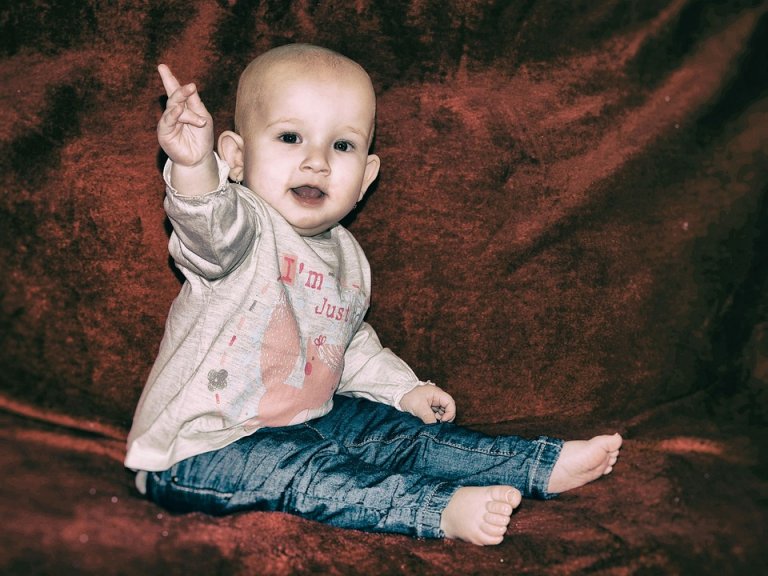Baby Sign Language: Non-Verbal Communication

Baby sign language gives you the ability to communicate with babies without words. This is especially helpful for babies who can understand more than they can speak because they’re acquiring language but don’t how to express themselves clearly. This form of communication reduces feelings of frustration in children who can’t express with words what they really want.
What is baby sign language?
As we previously mentioned, it’s a non-verbal form of communication. It includes different gestures and signs that help you communicate with a baby who can’t speak yet. Also, your child learns to use the signs to show adults what they need or want, without getting frustrated.

A baby that’s developing normally can begin to use this type of sign language after nine months of age. At this age, they can understand gestures and use them for the purpose of improving communication with their parents.
What you should know
In order for parents to be able to teach this type of tool to their children, they must be patient. That’s because some children will be able to learn it faster than others. This isn’t a good or a bad thing, it just means that you need to respect the pace of your little one’s learning.
To teach your little one, you’ll need to accompany the words or small phrases you use with gestures when interacting with your baby. That way, they’ll start to capture the simple gestures and will eventually be able to reproduce them whenever they want to express that they need or want something.
It’s important to keep in mind that it’ll take a lot of consistency and repetition for your child to learn these signs. Their learning is slow and you can’t expect your little ones to learn it as soon as they see the gesture.
Remember, they’ll need you to repeat the gesture at many different times so they understand that each gesture serves a specific purpose. Don’t be in a hurry. Instead, let your child learn at their own pace. The most important thing is that you also have to vocalize the word while you’re making the gesture that you want them to learn.
Advantages and disadvantages of baby sign language
As with everything, this tool can have its advantages and its disadvantages. It’s important to understand them so that you can use this tool effectively. That way, you can help your child communicate with you, even if they can’t speak yet.
Some of the advantages of baby sign language are:

- It helps you increase communication with your baby, even if they can’t speak yet.
- Children aren’t as frustrated by not being able to speak yet because they’re able to express their needs and wants to others.
- Facilitates speech for the child because they already have communication skills and intention.
- It strengthens the affective and emotional bond between parents and children. Communication is essential and, with baby sign language, the baby feels closer to their parents from an early age.
- Parents are more receptive when it comes to connecting with their little ones.
There aren’t many disadvantages of baby sign language. However, if we had to point one out, we’d say one issue is that your baby may adapt to sign language which could delay their spoken language. This would only happen if you misuse the strategy. For example, if you give the signs without also saying the word verbally each time you use baby sign language.
Conclusion
Baby sign language is a tool that Susan Goodwyn and Linda Acredolo created. If you’re interested in this non-verbal communication method, you can visit their website to find more information about this interesting topic. You can improve communication with your baby, even if your little one can’t speak. That’s because gestures are easier for your little one to learn than words.
So, what are you waiting for? Your baby will think it’s a game and it’ll be easier for you to communicate with them. In addition, you’ll be able to strengthen your bond with your little one. What more could you want?
Baby sign language gives you the ability to communicate with babies without words. This is especially helpful for babies who can understand more than they can speak because they’re acquiring language but don’t how to express themselves clearly. This form of communication reduces feelings of frustration in children who can’t express with words what they really want.
What is baby sign language?
As we previously mentioned, it’s a non-verbal form of communication. It includes different gestures and signs that help you communicate with a baby who can’t speak yet. Also, your child learns to use the signs to show adults what they need or want, without getting frustrated.

A baby that’s developing normally can begin to use this type of sign language after nine months of age. At this age, they can understand gestures and use them for the purpose of improving communication with their parents.
What you should know
In order for parents to be able to teach this type of tool to their children, they must be patient. That’s because some children will be able to learn it faster than others. This isn’t a good or a bad thing, it just means that you need to respect the pace of your little one’s learning.
To teach your little one, you’ll need to accompany the words or small phrases you use with gestures when interacting with your baby. That way, they’ll start to capture the simple gestures and will eventually be able to reproduce them whenever they want to express that they need or want something.
It’s important to keep in mind that it’ll take a lot of consistency and repetition for your child to learn these signs. Their learning is slow and you can’t expect your little ones to learn it as soon as they see the gesture.
Remember, they’ll need you to repeat the gesture at many different times so they understand that each gesture serves a specific purpose. Don’t be in a hurry. Instead, let your child learn at their own pace. The most important thing is that you also have to vocalize the word while you’re making the gesture that you want them to learn.
Advantages and disadvantages of baby sign language
As with everything, this tool can have its advantages and its disadvantages. It’s important to understand them so that you can use this tool effectively. That way, you can help your child communicate with you, even if they can’t speak yet.
Some of the advantages of baby sign language are:

- It helps you increase communication with your baby, even if they can’t speak yet.
- Children aren’t as frustrated by not being able to speak yet because they’re able to express their needs and wants to others.
- Facilitates speech for the child because they already have communication skills and intention.
- It strengthens the affective and emotional bond between parents and children. Communication is essential and, with baby sign language, the baby feels closer to their parents from an early age.
- Parents are more receptive when it comes to connecting with their little ones.
There aren’t many disadvantages of baby sign language. However, if we had to point one out, we’d say one issue is that your baby may adapt to sign language which could delay their spoken language. This would only happen if you misuse the strategy. For example, if you give the signs without also saying the word verbally each time you use baby sign language.
Conclusion
Baby sign language is a tool that Susan Goodwyn and Linda Acredolo created. If you’re interested in this non-verbal communication method, you can visit their website to find more information about this interesting topic. You can improve communication with your baby, even if your little one can’t speak. That’s because gestures are easier for your little one to learn than words.
So, what are you waiting for? Your baby will think it’s a game and it’ll be easier for you to communicate with them. In addition, you’ll be able to strengthen your bond with your little one. What more could you want?
This text is provided for informational purposes only and does not replace consultation with a professional. If in doubt, consult your specialist.








